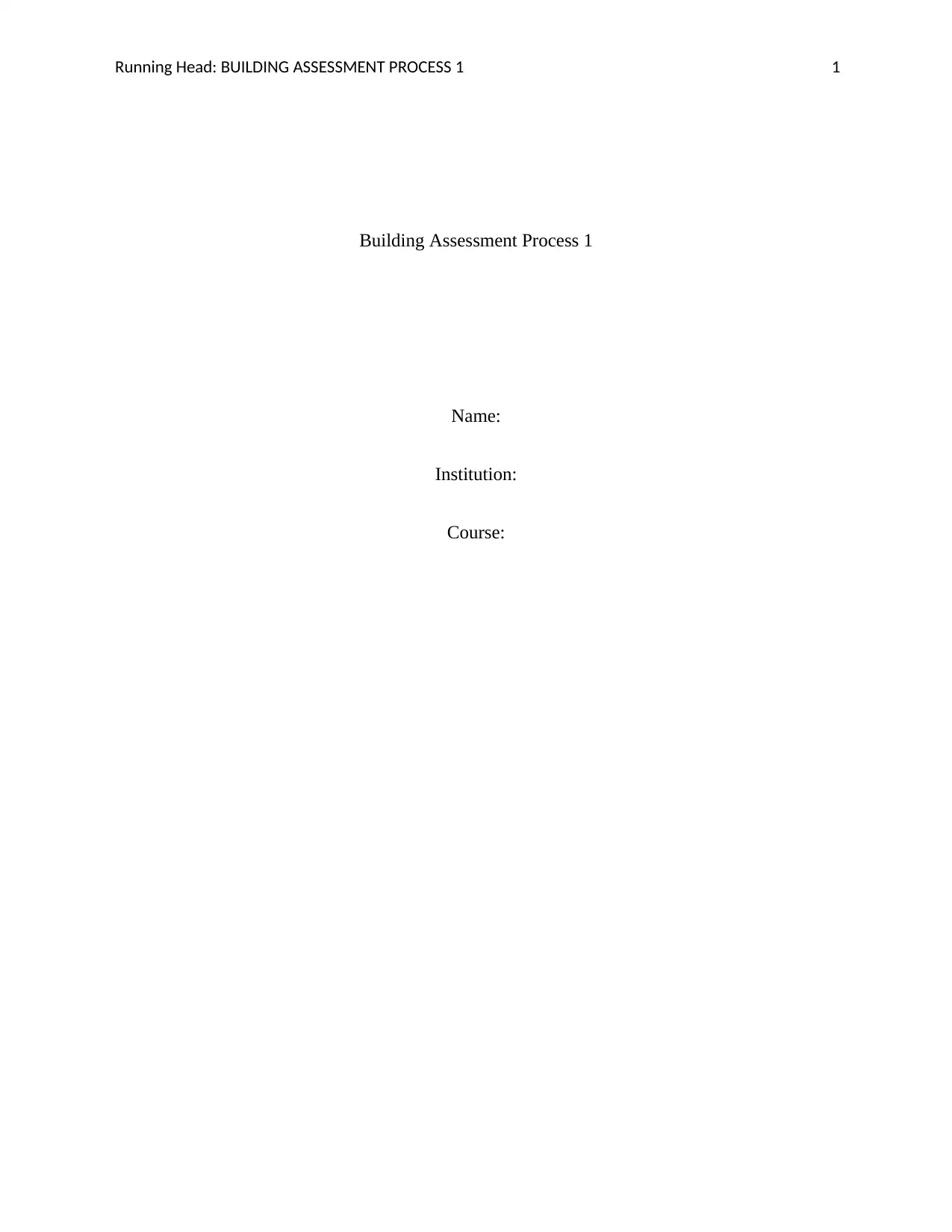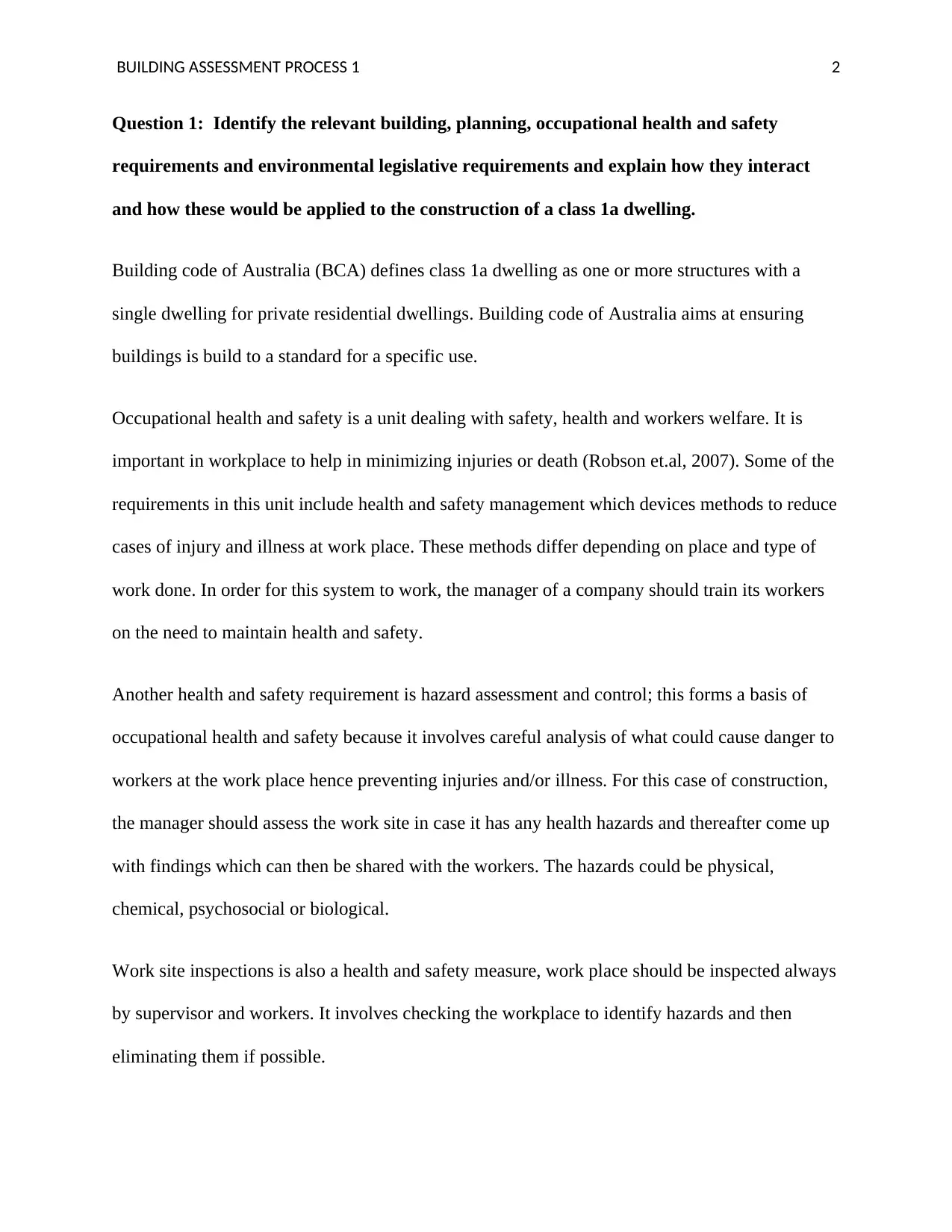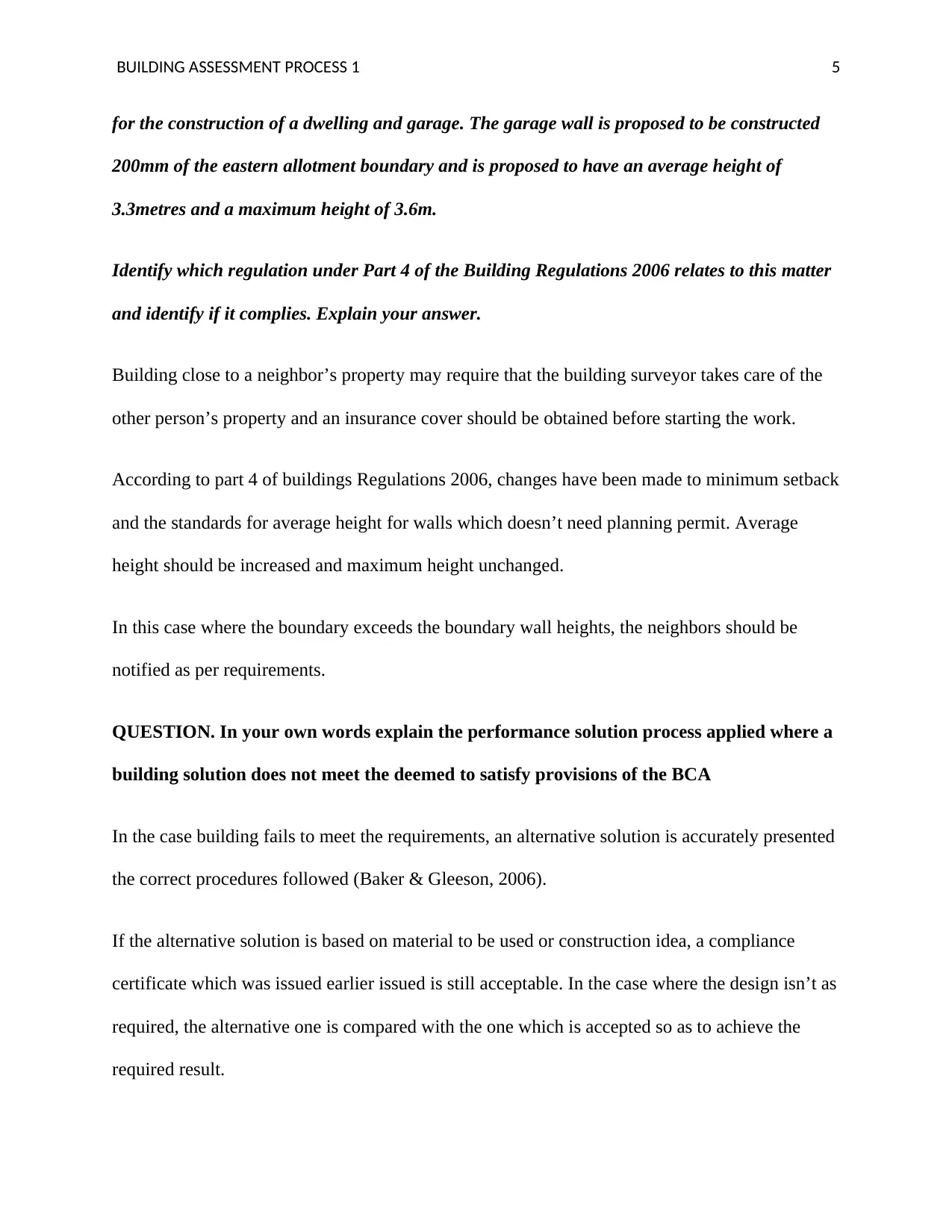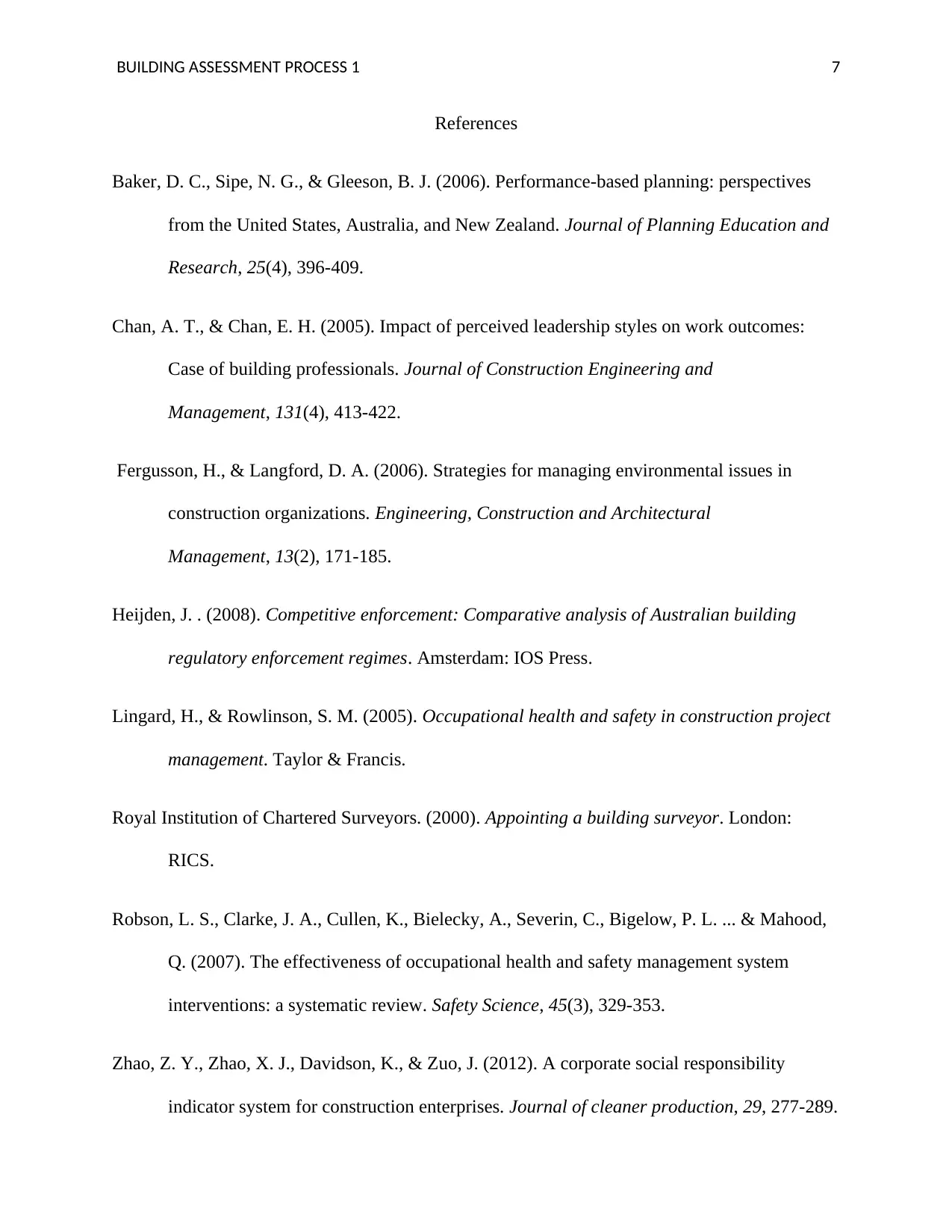Building Assessment Process 1 Report - Civil Engineering, Semester 1
VerifiedAdded on 2020/03/01
|8
|1560
|55
Report
AI Summary
This report delves into the multifaceted aspects of building assessment, commencing with an examination of the Building Code of Australia (BCA) and its application to class 1a dwellings. It thoroughly analyzes relevant building, planning, occupational health and safety, and environmental legislative requirements, emphasizing their interdependencies and practical application in construction projects. The report meticulously outlines occupational health and safety protocols, including hazard assessment, workplace inspections, incident management, and worker training. It also covers environmental legislative requirements such as environmental protection acts, environmental impact assessments, hazardous waste regulations, and water resource acts. Furthermore, the report provides a detailed overview of the building permit application process in Victoria, the roles of both private and municipal building surveyors, and the regulations concerning building setbacks. It concludes with an explanation of the performance solution process when building solutions do not meet the deemed-to-satisfy provisions of the BCA, providing a comprehensive understanding of the entire building assessment lifecycle.

Running Head: BUILDING ASSESSMENT PROCESS 1 1
Building Assessment Process 1
Name:
Institution:
Course:
Building Assessment Process 1
Name:
Institution:
Course:
Paraphrase This Document
Need a fresh take? Get an instant paraphrase of this document with our AI Paraphraser

BUILDING ASSESSMENT PROCESS 1 2
Question 1: Identify the relevant building, planning, occupational health and safety
requirements and environmental legislative requirements and explain how they interact
and how these would be applied to the construction of a class 1a dwelling.
Building code of Australia (BCA) defines class 1a dwelling as one or more structures with a
single dwelling for private residential dwellings. Building code of Australia aims at ensuring
buildings is build to a standard for a specific use.
Occupational health and safety is a unit dealing with safety, health and workers welfare. It is
important in workplace to help in minimizing injuries or death (Robson et.al, 2007). Some of the
requirements in this unit include health and safety management which devices methods to reduce
cases of injury and illness at work place. These methods differ depending on place and type of
work done. In order for this system to work, the manager of a company should train its workers
on the need to maintain health and safety.
Another health and safety requirement is hazard assessment and control; this forms a basis of
occupational health and safety because it involves careful analysis of what could cause danger to
workers at the work place hence preventing injuries and/or illness. For this case of construction,
the manager should assess the work site in case it has any health hazards and thereafter come up
with findings which can then be shared with the workers. The hazards could be physical,
chemical, psychosocial or biological.
Work site inspections is also a health and safety measure, work place should be inspected always
by supervisor and workers. It involves checking the workplace to identify hazards and then
eliminating them if possible.
Question 1: Identify the relevant building, planning, occupational health and safety
requirements and environmental legislative requirements and explain how they interact
and how these would be applied to the construction of a class 1a dwelling.
Building code of Australia (BCA) defines class 1a dwelling as one or more structures with a
single dwelling for private residential dwellings. Building code of Australia aims at ensuring
buildings is build to a standard for a specific use.
Occupational health and safety is a unit dealing with safety, health and workers welfare. It is
important in workplace to help in minimizing injuries or death (Robson et.al, 2007). Some of the
requirements in this unit include health and safety management which devices methods to reduce
cases of injury and illness at work place. These methods differ depending on place and type of
work done. In order for this system to work, the manager of a company should train its workers
on the need to maintain health and safety.
Another health and safety requirement is hazard assessment and control; this forms a basis of
occupational health and safety because it involves careful analysis of what could cause danger to
workers at the work place hence preventing injuries and/or illness. For this case of construction,
the manager should assess the work site in case it has any health hazards and thereafter come up
with findings which can then be shared with the workers. The hazards could be physical,
chemical, psychosocial or biological.
Work site inspections is also a health and safety measure, work place should be inspected always
by supervisor and workers. It involves checking the workplace to identify hazards and then
eliminating them if possible.

BUILDING ASSESSMENT PROCESS 1 3
Incident management and investigation is also another form of health and safety requirement.
This involves finding out the cause if an accident in the work place incase a worker has been
injured and finding good measures to prevent similar cases from happening.
To ensure good health and safety, Workers competency and training should also be taken into
consideration. Workers should be competent in what they do and should have good training on
how to operate machineries and know all safety measures. In a case where they are exposed to
danger, the manger should find a way of eliminating the dangers to avoid risking worker’s life
(Lingard & Rowlinson, 2005).
Emergency response and first aid, this is another requirement of health and safety. The work
place should have an emergency response where in case of a problem or fire, the workers have
an exit site to evade danger. In case of danger there should be first aid kits to offer first help
before proceeding to health centre in case the injury is serious.
When planning to erect a building, environmental legislative requirements are also taken into
consideration and they include; environmental protection act which defines the level of
contamination on a land to be used in erecting a building, it includes an idea that there can be a
possibility of harm caused by contamination and therefore thorough investigations should be
done(Fergusson & Langford,2006).
Environmental impact Assessment is a very crucial tool in assessing the impact of development
projects and finding out ways to reduce future impacts. This is expensive and time consuming.
Hazardous waste regulation which states that waste which is hazardous should be separated and
removed for disposal at the correct place.
Incident management and investigation is also another form of health and safety requirement.
This involves finding out the cause if an accident in the work place incase a worker has been
injured and finding good measures to prevent similar cases from happening.
To ensure good health and safety, Workers competency and training should also be taken into
consideration. Workers should be competent in what they do and should have good training on
how to operate machineries and know all safety measures. In a case where they are exposed to
danger, the manger should find a way of eliminating the dangers to avoid risking worker’s life
(Lingard & Rowlinson, 2005).
Emergency response and first aid, this is another requirement of health and safety. The work
place should have an emergency response where in case of a problem or fire, the workers have
an exit site to evade danger. In case of danger there should be first aid kits to offer first help
before proceeding to health centre in case the injury is serious.
When planning to erect a building, environmental legislative requirements are also taken into
consideration and they include; environmental protection act which defines the level of
contamination on a land to be used in erecting a building, it includes an idea that there can be a
possibility of harm caused by contamination and therefore thorough investigations should be
done(Fergusson & Langford,2006).
Environmental impact Assessment is a very crucial tool in assessing the impact of development
projects and finding out ways to reduce future impacts. This is expensive and time consuming.
Hazardous waste regulation which states that waste which is hazardous should be separated and
removed for disposal at the correct place.
⊘ This is a preview!⊘
Do you want full access?
Subscribe today to unlock all pages.

Trusted by 1+ million students worldwide

BUILDING ASSESSMENT PROCESS 1 4
Water resource act states that it is an offence to dispose waste to water bodies knowingly. This
can occur through surface flow or through infiltration (Zhao, et.al, 2012). Therefore when
planning to build a structure, waste disposal should be considered.
Question: Explain the building permit application process in Victoria
Building permit is a document giving authority to build and before applying it, a building
surveyor is required .After getting a surveyor, you now apply for the permit and make payments,
submit drawings, allotment allocation (Heijden, 2008). Thereafter it is checked for compliance
under act and regulations and then makes a decision to issue permit with or without conditions.
Question: What is the role of a building surveyor both private and municipal
Building surveyor is trained person with a great and deep knowledge of building control
processes. There are two types; private and municipal building surveyor.Private building
surveyor is a person who does his privately, while municipal surveyor works under local
government or council.
The roles of a building surveyor include issuing building permit, carry out inspections of
buildings and work done and also issue occupancy permit. They show their competent skills by
assessing and evaluation work plans (Chan & Chan, 2005).
Building surveyor ensures that all documents from all authorities are obtained. They also do the
inspection work to buildings under construction to ensure that act regulations and BCA are
adhered to.
QUESTION. You are the relevant building surveyor and are assessing a permit application
Water resource act states that it is an offence to dispose waste to water bodies knowingly. This
can occur through surface flow or through infiltration (Zhao, et.al, 2012). Therefore when
planning to build a structure, waste disposal should be considered.
Question: Explain the building permit application process in Victoria
Building permit is a document giving authority to build and before applying it, a building
surveyor is required .After getting a surveyor, you now apply for the permit and make payments,
submit drawings, allotment allocation (Heijden, 2008). Thereafter it is checked for compliance
under act and regulations and then makes a decision to issue permit with or without conditions.
Question: What is the role of a building surveyor both private and municipal
Building surveyor is trained person with a great and deep knowledge of building control
processes. There are two types; private and municipal building surveyor.Private building
surveyor is a person who does his privately, while municipal surveyor works under local
government or council.
The roles of a building surveyor include issuing building permit, carry out inspections of
buildings and work done and also issue occupancy permit. They show their competent skills by
assessing and evaluation work plans (Chan & Chan, 2005).
Building surveyor ensures that all documents from all authorities are obtained. They also do the
inspection work to buildings under construction to ensure that act regulations and BCA are
adhered to.
QUESTION. You are the relevant building surveyor and are assessing a permit application
Paraphrase This Document
Need a fresh take? Get an instant paraphrase of this document with our AI Paraphraser

BUILDING ASSESSMENT PROCESS 1 5
for the construction of a dwelling and garage. The garage wall is proposed to be constructed
200mm of the eastern allotment boundary and is proposed to have an average height of
3.3metres and a maximum height of 3.6m.
Identify which regulation under Part 4 of the Building Regulations 2006 relates to this matter
and identify if it complies. Explain your answer.
Building close to a neighbor’s property may require that the building surveyor takes care of the
other person’s property and an insurance cover should be obtained before starting the work.
According to part 4 of buildings Regulations 2006, changes have been made to minimum setback
and the standards for average height for walls which doesn’t need planning permit. Average
height should be increased and maximum height unchanged.
In this case where the boundary exceeds the boundary wall heights, the neighbors should be
notified as per requirements.
QUESTION. In your own words explain the performance solution process applied where a
building solution does not meet the deemed to satisfy provisions of the BCA
In the case building fails to meet the requirements, an alternative solution is accurately presented
the correct procedures followed (Baker & Gleeson, 2006).
If the alternative solution is based on material to be used or construction idea, a compliance
certificate which was issued earlier issued is still acceptable. In the case where the design isn’t as
required, the alternative one is compared with the one which is accepted so as to achieve the
required result.
for the construction of a dwelling and garage. The garage wall is proposed to be constructed
200mm of the eastern allotment boundary and is proposed to have an average height of
3.3metres and a maximum height of 3.6m.
Identify which regulation under Part 4 of the Building Regulations 2006 relates to this matter
and identify if it complies. Explain your answer.
Building close to a neighbor’s property may require that the building surveyor takes care of the
other person’s property and an insurance cover should be obtained before starting the work.
According to part 4 of buildings Regulations 2006, changes have been made to minimum setback
and the standards for average height for walls which doesn’t need planning permit. Average
height should be increased and maximum height unchanged.
In this case where the boundary exceeds the boundary wall heights, the neighbors should be
notified as per requirements.
QUESTION. In your own words explain the performance solution process applied where a
building solution does not meet the deemed to satisfy provisions of the BCA
In the case building fails to meet the requirements, an alternative solution is accurately presented
the correct procedures followed (Baker & Gleeson, 2006).
If the alternative solution is based on material to be used or construction idea, a compliance
certificate which was issued earlier issued is still acceptable. In the case where the design isn’t as
required, the alternative one is compared with the one which is accepted so as to achieve the
required result.

BUILDING ASSESSMENT PROCESS 1 6
If in the case of a requirement which can be measured, a computer can be used to find out if
requirements are met as per performance.
Design and analysis documents of the alternative solution can be submitted for recording
purposes to show that the requirements have been met, making approval process of alternative
solution faster.
If in the case of a requirement which can be measured, a computer can be used to find out if
requirements are met as per performance.
Design and analysis documents of the alternative solution can be submitted for recording
purposes to show that the requirements have been met, making approval process of alternative
solution faster.
⊘ This is a preview!⊘
Do you want full access?
Subscribe today to unlock all pages.

Trusted by 1+ million students worldwide

BUILDING ASSESSMENT PROCESS 1 7
References
Baker, D. C., Sipe, N. G., & Gleeson, B. J. (2006). Performance-based planning: perspectives
from the United States, Australia, and New Zealand. Journal of Planning Education and
Research, 25(4), 396-409.
Chan, A. T., & Chan, E. H. (2005). Impact of perceived leadership styles on work outcomes:
Case of building professionals. Journal of Construction Engineering and
Management, 131(4), 413-422.
Fergusson, H., & Langford, D. A. (2006). Strategies for managing environmental issues in
construction organizations. Engineering, Construction and Architectural
Management, 13(2), 171-185.
Heijden, J. . (2008). Competitive enforcement: Comparative analysis of Australian building
regulatory enforcement regimes. Amsterdam: IOS Press.
Lingard, H., & Rowlinson, S. M. (2005). Occupational health and safety in construction project
management. Taylor & Francis.
Royal Institution of Chartered Surveyors. (2000). Appointing a building surveyor. London:
RICS.
Robson, L. S., Clarke, J. A., Cullen, K., Bielecky, A., Severin, C., Bigelow, P. L. ... & Mahood,
Q. (2007). The effectiveness of occupational health and safety management system
interventions: a systematic review. Safety Science, 45(3), 329-353.
Zhao, Z. Y., Zhao, X. J., Davidson, K., & Zuo, J. (2012). A corporate social responsibility
indicator system for construction enterprises. Journal of cleaner production, 29, 277-289.
References
Baker, D. C., Sipe, N. G., & Gleeson, B. J. (2006). Performance-based planning: perspectives
from the United States, Australia, and New Zealand. Journal of Planning Education and
Research, 25(4), 396-409.
Chan, A. T., & Chan, E. H. (2005). Impact of perceived leadership styles on work outcomes:
Case of building professionals. Journal of Construction Engineering and
Management, 131(4), 413-422.
Fergusson, H., & Langford, D. A. (2006). Strategies for managing environmental issues in
construction organizations. Engineering, Construction and Architectural
Management, 13(2), 171-185.
Heijden, J. . (2008). Competitive enforcement: Comparative analysis of Australian building
regulatory enforcement regimes. Amsterdam: IOS Press.
Lingard, H., & Rowlinson, S. M. (2005). Occupational health and safety in construction project
management. Taylor & Francis.
Royal Institution of Chartered Surveyors. (2000). Appointing a building surveyor. London:
RICS.
Robson, L. S., Clarke, J. A., Cullen, K., Bielecky, A., Severin, C., Bigelow, P. L. ... & Mahood,
Q. (2007). The effectiveness of occupational health and safety management system
interventions: a systematic review. Safety Science, 45(3), 329-353.
Zhao, Z. Y., Zhao, X. J., Davidson, K., & Zuo, J. (2012). A corporate social responsibility
indicator system for construction enterprises. Journal of cleaner production, 29, 277-289.
Paraphrase This Document
Need a fresh take? Get an instant paraphrase of this document with our AI Paraphraser

BUILDING ASSESSMENT PROCESS 1 8
1 out of 8
Related Documents
Your All-in-One AI-Powered Toolkit for Academic Success.
+13062052269
info@desklib.com
Available 24*7 on WhatsApp / Email
![[object Object]](/_next/static/media/star-bottom.7253800d.svg)
Unlock your academic potential
Copyright © 2020–2025 A2Z Services. All Rights Reserved. Developed and managed by ZUCOL.





